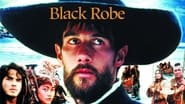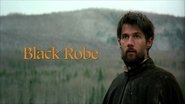ThiefHott
Too much of everything
NekoHomey
Purely Joyful Movie!
Janae Milner
Easily the biggest piece of Right wing non sense propaganda I ever saw.
Derry Herrera
Not sure how, but this is easily one of the best movies all summer. Multiple levels of funny, never takes itself seriously, super colorful, and creative.
weezeralfalfa
A film adaptation of Brian Moore's novel of the same title, which I haven't read. It concerns a 1634 expedition, starting from Quebec, up the St. Lawrence, and beyond to a Huron mission, led by Jesuit LaForgue, who wears the traditional black robe and broad-rimmed hat. Another member, Daniel, speaks Algonquin, and initially professes an interest in becoming a Jesuit, if he returns. There are also several canoes filled with Algonquin guides and some of their family. This includes Chomina, his wife, and marriageable daughter, Annuka. Along the way, they encounter another Algonquin tribe, as well as Mohawks, who take them prisoner, and Hurons suffering a smallpox epidemic.To me, the most revealing character is Daniel: the laymen who accompanied LaForgue on this expedition. When LaForgue talks up the advantages of Christianity to the Indians, Daniel notes that they are already acting more like true Christians than most Europeans, in that they live for each other, and forgive things that most Europeans would not forgive. They also have their own idea of an afterlife. They believe that the spirits of the deceased emerge at night to hunt the spirits of departed animals. They are not interested in a place where most of the spirits are Westerners, and where the spirits aren't allowed to smoke tobacco or make love to female spirits . Daniel, having the advantage of speaking Algonquin, feels more at ease with their beliefs and customs. Thus, he soon begins a sexual relationship with Annuka. However, it's clear she's not a virgin, as he watches her making love with an Indian in their Tepee. Also, she flaunts her sexuality toward the Iroquois guard of their tepee, when awaiting death in the morrow, to chance a possible rendering of the guard unconscious. This promiscuity doesn't particularly bother Daniel, although LaForgue considers it a sin for him to lust after even an unmarried girl. Annuka's father discourages her from continuing a relationship with Daniel, claiming he is ugly and a stupid European. Annuka thinks it's very strange that LaForgue isn't interested in sexual relations. In consequence, she suspects he may be a devil. But Daniel explains that his position requires him to be celibate. The last part of the film follows LaForgue, alone of the original party. Thus, we are left wondering what became of Daniel and Annuka, who are left at the threshold of entering the Huron mission.When LaForgue enters the Huron mission, and finds all the Europeans killed, except Rev. Jerome, Jerome tells him that the Hurons killed them because they blamed them for the smallpox epidemic, thinking that this plague was unleashed on them because they resisted converting to Christianity. Historically, frontier doctor Marcus Whitman along with other Europeans, were massacred because the Indians noticed that his European measles patients mostly recovered, whereas his Indian patients seldom did. I agree that LaForge and the Indians(Algonquin and Huron)gradually became more tolerant of the other's customs and thinking. He began to see the Indians as more than just fodder for his conversion ambitions. At the end, the Hurons ask if he loved them. After some delay, he answered "yes". Then, he baptized them with the understanding that this would not cure or prevent their smallpox sickness, but would qualify them to a chance of entering heaven.
Chris Impens
A most impressive movie. For once, politically correct stuff has been reduced to the absolute minimum, namely a transcultural love story-- feeble but tolerable. Apart from that, everything is as it should be. The scenery is breathtaking, the score likewise, and the characters, each one a prisoner in his own universe, are very convincing. The last words on the screen are as strong a message as everything else in the movie: the Hurons, turned Christian because they expect some medical profit from the priest's "water remedy", are overrun and exterminated by their pagan neighbours. So, in the end, nothing whatsoever is left from the desperate attempt we have witnessed.
sleepsinclassz
Gorgeous movie. My only real problem is the screen at the end claiming that the Indians got wiped out after they converted. They did, ... but there was also this little thing called the French and Indian War.And in that war, these Indians happened to side with the French. The F&I War was pretty dang big, cost enough money to cause the American Revolution a few years later, and ended in a gargantuan battle where the British won because the kill ratio was 3 dead French/allies for every 2 British/allies.So yeah, the movie's a little disingenuous there.Also, what's with this stupid 10-line minimum?
MacAindrais
Black Robe (1991) Released with poor timing in the aftermath of a similar themed film - Kevin Costner's Dances with Wolves - Black Robe largely got lost in the shuffle. That's a shame, because the film is actually quite remarkable. Not to say that it hasn't had influence on other films however. Black Robe certainly must have had quite an influence on Terrence Malick and his The New World. The title credits are clearly inspired by those in Black Robe, and other aspects are familiar as well.Set in 17th century Quebec, the film follows a young Jesuit priest, Father Lafourgue (Bluteau), referred to as Black Robe by the natives. He travels with a band Algonquins lead by Chomina (Schellenberg). With Father Lafourgue is Daniel, a young Frenchman, who is in love with Chomina's daughter. The young priest soon begins to inspire fears that he is some sort of demon, and many in the band wish to leave him behind, or possibly even kill him and his companion.Their travels meet turmoil among other hostile native tribes, leading not only a struggle between peoples, but a struggle between faiths. Beresford creates a very bleak atmosphere, using the cold Quebec landscape as an intimidating, but still beautiful backdrop. The weather feels cold, the air crisp. It's really quite a beautiful film to look at.Bruce Moore, who wrote the screenplay and the novel it was based on, went to great lengths in research to accurately portray this period in time. Many have praised the film for its accuracies, while a number of others have however complained that it shows natives as savages. I have to disagree. Neither side is shown as total bad guys, nor total good guys. The film gives everyone a fair shake. Both sides have/had their reasons, and both sides committed terrible acts. Certainly, not all Natives were all about peace and love, which is not a slight to them in the least. Their history is a noble one, and they had every right to fear and be hostile in the face of Europeans. That said, I'm probably overcompensating for the film, because it really doesn't show Natives as savages at all, especially not the Algonquins. Moore claimed, in fact, that he actually toned down the violence of the Natives compared to what he found in his research. That said, what he found in his research was most likely overstated to begin with.Black Robe certainly is a bleak picture. The naturalistic photography and tone adds to the depressed atmosphere. This is not a story of joys, but of sorrows. When the film ends, we are told what history has already told us - the Natives were slaughtered and the Jesuit's mission by and large was a futile failure.Though the film sticks to its own dark history, this is more than just a very well done history lesson. Black Robe is a parable of the horrifying results that come from misunderstanding, miscommunication, and ignorance. While the Jesuit mission was well intentioned, it was more a product of Eurocentric ignorance than anything else. The Native people had their own religious beliefs, and the film shows that. The lessons in Black Robe are transferable to any number of modern day conflicts. We have not learned our lesson, and by removing the gloss and glamour off the period epics of old, Black Robe serves as a reminder. Such a shame its so overlooked.




